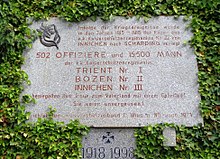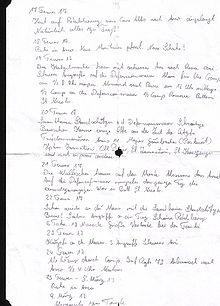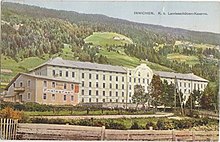Imperial and Royal Rifle Regiment "Innichen" No. III
The Imperial Emperor Rifle Regiment "San Candido" no. III was an infantry federation of Austrian Landwehr and belonged to kk Gebirgstruppe .
Naming
The original name was kk Landesschützen-Regiment Nr. III and was supplemented in 1897 by the addition of the garrison of the regimental staff. From then on it was called Imperial Rifle Regiment "Trient" No. III . From March 1st, 1909 (date of the re-establishment) it was named Imperial Rifle Regiment "Innichen" No. III and was last changed by a decree of Emperor Karl I on January 16th, 1917 to Imperial and Royal Kaiserschützen Regiment "Innichen" No. III renamed. There was no official reason for this.
Lineup
On May 1, 1893, the ten existing state rifle battalions were combined into regiments. The regiment No. III (only the state riflemen were numbered in Roman numerals) emerged from the merger of the former state rifle battalions:
Since the recruitment quotas from Tyrol (Northern, Southern Trento ) and Vorarlberg were not sufficient to form three complete regiments in the war-footing, was dissolved on 30 October 1901, the "Regiment of Trento" and the staff at the kk-country Rifle Regiment No. II transferred.

Due to the extraordinary attractiveness of the state riflemen, who had been converted into a mountain troop since May 1, 1906, the number of volunteers and also the recruitment requests rose so much that one felt compelled to enter the III. To set up regiment again.
Thereupon the regiment with staff garrison San Candido was put back into service. The area from the Dolomites to the Carinthian border was assigned to him as a combat section . At the same time, like the others, it had to deploy detachments to garrison the fortifications .
Composition and association membership
- 88th Landess Rifle Brigade - 44th Landwehr Infantry Division - XIV Army Corps
- Ethnic composition: 59% German-speaking - 38% Italian-speaking - 3% others
- Regimental language: German
(This Landwehr regiment initially had four battalions, until the 4th battalion was transferred to the Landesschützen Regiment No. I.)
The ethnic composition could no longer be covered with the extremely heavy losses from the Tyrolean countries and Vorarlberg alone, so that more and more replacements from other parts of the country had to be added to the regiment during the course of the war. It is doubtful whether the Tyrolean / Vorarlberg (not related to German-speaking) share still reached the 50% mark in 1918.
Dislocation

- Peace garrison: staff, IV. Baon Innichen / I. Baon Primör / II. Baon Predazzo / III. Baon Cortina d'Ampezzo
- The supplementary command and the replacement battalion squad were relocated to Schärding in 1915 .
- Training stations
For specific mountain training, the state riflemen were relocated to summer stations. There were smaller barracks there or suitable buildings (larger inns) were rented.
| Command headquarters | Winter garrison | Summer station |
|---|---|---|
| Regimental Kdo. | San Candido | San Candido |
| I. Baon-Kdo. | Fiera di Primiero | Fiera di Primiero - 46 ° 10 ′ 31 ″ N , 11 ° 49 ′ 51 ″ E |
| 1st comp. | Fiera di Primiero | Canal San Bovo - 46 ° 9 ′ 21 ″ N , 11 ° 44 ′ 0 ″ E |
| 2nd comp. | Fiera di Primiero | Fiera di Primiero |
| Geb.MG Abt III / 1 | Fiera di Primiero | Fiera di Primiero |
| II. Baon-Kdo. | Predazzo | Moena - 46 ° 22 ′ 34 " N , 11 ° 39 ′ 36" E |
| 3rd comp. | Predazzo | Piano di Cason |
| 4th comp. | Predazzo | San Pellegrino - 46 ° 22 ′ 42 " N , 11 ° 47 ′ 24" E |
| 5th comp. | Predazzo | Penia - 46 ° 27 ′ 28 ″ N , 11 ° 47 ′ 55 ″ E |
| MG Abbot III / 2 | Predazzo | Moena |
| III.Baon-Kdo. | Cortina d'Ampezzo | Cortina d'Ampezzo |
| 6th comp. | Cortina d'Ampezzo | Andraz - 46 ° 29 ′ 1 ″ N , 11 ° 59 ′ 2 ″ E |
| 7th comp. | Cortina d'Ampezzo | Cortina d'Ampezzo |
| MG Abt III / 3 | Cortina d'Ampezzo | Cortina d'Ampezzo |
| IV.Baon.-Kdo. | San Candido | Sexten |
| 8th comp. | San Candido | Schluderbach - 46 ° 37 ′ 12 ″ N , 12 ° 13 ′ 2 ″ E |
| 9th comp. | San Candido | Sexten |
| 10th comp. | San Candido | Obertilliach - 46 ° 42 ′ 35 ″ N , 12 ° 36 ′ 55 ″ E |
| Geb. MG Dept. III / 4 | San Candido | Sexten |
- In case of war
The area from the Dolomites to the Carinthian border was assigned to him as a combat section . At the same time, like the others, it had to deploy detachments to garrison the fortifications . (According to current law, the state riflemen were only allowed to be used to protect the homeland or to defend the borders of Tyrol and Vorarlberg. In order to circumvent this regulation, the fight against Russia was simply declared necessary to protect the homeland .)
Regimental commanders
- 1893 to April 1898: Lieutenant Colonel / Colonel Ing.Joseph Schediwy
- April 1889 to September 1901: Lieutenant Colonel / Colonel Otto Filippini-Höffern
- March 1909 to March 1914: Lieutenant Colonel / Colonel Karl Georgi
- April 1914 to September 1914 Lieutenant Colonel / Colonel Hugo Schönherr
- September to October 1914: Lieutenant Colonel Theodor Spiegel
- October to December 1914: Colonel Josef Stiller
- December 1914 to March 1918: Colonel Josef Hadasczcok
- March to December 1918: Colonel Gabriel Graf Gudenus
Uniformity
The regiment wore the uniform of the mountain troops introduced in 1907 . This consisted of the following pieces of equipment:
- Pike-gray field cap with attached play tap (in the field the play tap was only put on on command)
- Pike gray blouse with patch pockets and grass green parolis . Officers to parade or on orders with shoulder boards.
- Pike-gray knee breeches with knee-high wool stockings
- Mountain boots
- Officers and batches carried the short saber
This was both field and parade adjustments . In contrast to this, officers in parade adjustment had to wear the old outfit as an individual (e.g. for the award of medals). This consisted of:
- Hunter's hat with plume
- Pike gray tunic with grass green equalization and shoulder pieces
- Gold / black interwoven field band . Infantry officer's saber .
- Pike-green pantaloons with grass-green piping and lampasses
- Black ankle boots
Battle days of the regiment in the First World War
- 1914
On August 1, 1914, the regiment mobilized and was transferred to the Russian front by rail. The association gathered in the Grodek area from August 17th to 25th and marched to Lemberg until August 26th .
Battle of Lviv
- August 27: Battle at Dunayov
- August 29th to 31st: Battles at Firlejow, Wojcieowice, Solowa and Lany. Then retreat to Grodek.
Battle of Grodek
- September 8th: Battle at Lelechowka-Janow
- September 9: Battle at Jägerhaus-Stawki (Lelechowka)
- September 10-12: Skirmishes at Buliawa and Stawki
- to October 2nd: retreat behind the San
- October 3: advance on Przemysl to relieve the besieged fortress
- October 14-18: Battles around the heights of Liskowiec
- October 18 to November 3: Skirmishes and trench warfare east of Stroniowice
- November 4th: retreat behind the Dunajec
- November 20-25: Battles near Doly-Porutka and Wisnicz
- November 28th to December 4th: March to Krakow and skirmishes in the fortress area
- December 5th: March to Lapanow
- December 7th to
- 1915
- February 21: Trench warfare near Chojnik
- February 22nd to March 2nd: Relocation of the regiment to East Galicia
- March 10: Battle near Manasterczany
- March 11th to 20th: Restoration (rest)
- March 21: Postponed to Sniatyn
- March 23 to May 8: Attacks on the Zalezczyki bridgehead with the capture of it on May 8
- May 9th to July 13th: Trench warfare and skirmishes in the Raszkow, Horodenka, Zablotow area. Advance on the Dniester with aggressive fighting at Horodnica, Zedzawa and Dzwiniacz
July 27: Relocation to the Italian front begins.
The X. and XI. Marching battalions had not been sent to the Eastern Front any more, but were sent directly to the Italian front. The crews of the fortifications (detachment of the Xth March Battalion in the Plätzwiese plant and in the Landro plant ) had also been in this section for a long time.
The 10th March Battalion fought from May 23 to May 26 at Eisenreich-Col di Frugioni and at Tillacher Joch-Wildkarleck. In mid-June it took part in the storming of Monte Piano and defended it against Italian attacks on June 20.
The XI. March Battalion (later rededicated to V Field Battalion) was involved in fighting on the Three Peaks from August 18 to 20 .
- 28 July to 18 August: The regiment moved to the Isonzo front and, increased to five battalions, was used as an army reserve in the Ovcja - Draga area.
- August 19: Rail transport to the front in Tyrol.
- August 20 to September 26: Fights in the area around Monte Piano
- October 19-23: The 5th battalion fought on the plateau of the seven municipalities in the Pioverna alta area.
- November 7th to
- 1916
- March 15th: The Col di Lana is re- stormed for trench warfare in the Dolomites . Afterwards, the association was merged in the Piné Valley near Baselga
- May 18 and 19: Transport via Trient-Matarello to the Rovereto area .
- May 21st to May 30th: Participation in the spring offensive with heavy fighting in the Vallarsa area, near Passo Buole and Coni Zugna.
- June 15 to
- 1917
- October 1917: Trench warfare on the Marmolada , the Cauriol, Colbricon, Costa Bella, Gardinal and Busa Alta. Then transfer to the Isonzo Front to take part in the Twelfth Isonzo Battle .
- December 4th: Storming the Badeleche height and Mt. Tondarecar, storming Mt. Miela and Mt. Meletta
- December 5th: Storming of Mt. Zoni near Gallio
- December 6th: Fight at Foza
- December 24th to 27th: Storming of San Rosso followed by trench warfare.
- 1918
- March 15th: Transport back to Vallarsa. There until November 3rd position battles on Zugna Torta and Monte Corno.
- November 3rd: The regiment on the march back home was captured by the Italians who were advancing without resistance in S. Sebastiano (Folgaria plateau). (For reasons that have not yet been explored, the Austro-Hungarian High Command informed the troops that November 3rd was the end of the war, although November 4th was expressly stated in the armistice negotiations. In this way, the Italians managed to capture more than 300,000 Austro-Hungarian soldiers .)
Awards
Two members of the regiment were awarded the highest Austro-Hungarian bravery award, the Military Maria Theresa Order:
- Major Konstantin Valentini, Conqueror of Meletta (1917)
- Lieutenant Peter Scheider, conqueror of the Monticello ridge (1918)
Others
The regiment's motto was: "Always vigilant and combative."
Regimental march
The regimental march - the Kaiserschützenmarsch - was the same for all three Landesschützen / Kaiserschützen regiments .
Individual evidence
-
↑ Wording of the decree: I order that from now on the state riflemen are called Kaiserschützen. I am convinced that these brave troops, who have won immortal laurels until now, will make the new name shine in glory, for my joy, for their honor and for the good of the fatherland.
Karl mp - ↑ Kaiserschützenmarsch on YouTube
literature
- Austria-Hungary's last war 1914–1918. Volume I - VII. Verlag der Militärwissenschaftlichen Mitteilungen, Vienna 1930–39.
- Hermann Hinterstoisser, M.Christian Ortner , Erwin A. Schmidl: The kk Landwehr mountain troops. Militaria Publishing House, Vienna 2006.
- Heinz von Lichem : With a play tap and edelweiss. Athesia Verlag Bozen 1981.
- Adjustment regulation for the Austro-Hungarian Army, the Imperial and Royal Landwehr, the Imperial and Royal Landwehr, the associated institutions and the corps of military officials. Published by the kk war ministry Vienna 1867 (adapted and expanded edition by the kuk war ministry from 1912).





